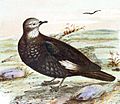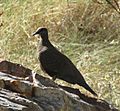White-quilled rock pigeon facts for kids
Quick facts for kids White-quilled rock pigeon |
|
|---|---|
 |
|
| Conservation status | |
| Scientific classification | |
| Genus: |
Petrophassa
|
| Species: |
albipennis
|
The white-quilled rock pigeon (Petrophassa albipennis) is a dark brown rock pigeon. It has a special white patch on its wing. You can also spot it by the pale lines that curve above and below its eyes. This bird is a type of bird in the Columbidae family.
These pigeons live among rocks, especially on sandstone cliffs and tall rock formations. You can find them in the Kimberley area of Western Australia and east of the Victoria River in the Northern Territory. They are found only in Australia, which means they are endemic to this country.
Contents
What is a White-quilled Rock Pigeon?
There are two types of rock pigeons in Australia. These are the white-quilled rock pigeon and the chestnut-quilled rock pigeon. They are called "rock pigeons" because they love living in rocky places like sandstone gorges and cliffs.
How the White-quilled Rock Pigeon Got Its Name
The white-quilled rock pigeon was first identified and named by a person named John Gould in 1841. The name Petrophassa albipennis fits this bird very well.
The first part of its scientific name, Petrophassa, comes from two Greek words. Petros means "rock," which is where these pigeons like to live. Phassa means "wild pigeon." So, Petrophassa means "rock pigeon."
The second part of its name, albipennis, comes from Latin words. Albus means "dull white," and penna means "feather." This refers to the big white patch on its wing, which you can see when it flies.
Different Types of White-quilled Rock Pigeons
Scientists recognize two slightly different groups, called subspecies, of the white-quilled rock pigeon:
- P. a. albipennis: This group was named in 1841. You can find them in the Kimberley region of Western Australia (WA). They also live in the northwest of the Northern Territory (NT), as far east as the upper Daly River.
- P. a. boothi: This group was named in 1969. They live in a smaller area around the Victoria River in the Northern Territory.
What Does the White-quilled Rock Pigeon Look Like?
The white-quilled rock pigeon is a fairly large bird. It is usually a mid-brown to reddish-brown color. Its wings are about 12 to 14.5 centimeters long. Its beak is about 1.1 to 1.45 centimeters long.
The albipennis subspecies, found mostly in Western Australia, weighs between 117 and 156 grams. The boothi subspecies, found in the Northern Territory, is a bit smaller, weighing between 103 and 142 grams.
This pigeon has white spots on its chin and forehead. The skin around its eyes is grey. While its common name comes from the white patches on its wings, its face markings are also very special. It has thin, pale lines that go across its face. These lines curve above and behind its eye, and also below its eye and across the sides of its head.
The albipennis subspecies has large white patches on its wings. The boothi subspecies has smaller white patches.
How Does the White-quilled Rock Pigeon Behave?
The IUCN Red List says that the white-quilled rock pigeon is of "Least Concern" (LC) for its survival worldwide. This means it is not currently in danger. However, in the Northern Territory, its conservation status is listed as "Near Threatened" (NT). This means it could become threatened in the future if things change.
Where They Live and How They Move
These pigeons live in rocky escarpments and gorges. They move very easily among the rocks and large stones. They have a special way of standing, called a jizz, which is similar to the chestnut-quilled rock pigeon. They often stand on a high rock or ledge with their body held flat. Their tail is held up off the ground, and their wings hang down below their tail.
Early Discoveries About the Pigeon
The first detailed notes about the white-quilled rock pigeon were made when some birds were collected by officers from a ship called HMS Beagle. The ship's commander, John Lort Stokes, wrote about his travels in Australia:
"(Feb. 11) . . . Some rather small pigeons (Petrophila albipennis Gould),of a dark brown colour, marked with a white patch on the wings, were seen, and some specimens shot. They made a whirring sound in flight, like the partridge, and appeared to haunt the rocks; a habit which all subsequent observation confirmed."
Flight and Feeding
When these pigeons fly, they make a loud, clattering sound with their wings. They often glide from one high rock to another. They look for food in the grassy woodlands nearby. But if they get scared, they quickly fly back to their rocky cliffs where they feel safe.
Gallery
See also
 In Spanish: Paloma roquera aliblanca para niños
In Spanish: Paloma roquera aliblanca para niños






